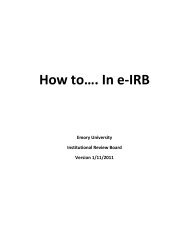A Manual for Participants in Clinical Trials of Investigational Agents ...
A Manual for Participants in Clinical Trials of Investigational Agents ...
A Manual for Participants in Clinical Trials of Investigational Agents ...
You also want an ePaper? Increase the reach of your titles
YUMPU automatically turns print PDFs into web optimized ePapers that Google loves.
Integrated biomarkers are not used to determ<strong>in</strong>e treatment <strong>in</strong> the trial, but are clearly<br />
identified as part <strong>of</strong> the trial from the beg<strong>in</strong>n<strong>in</strong>g and are <strong>in</strong>tended to identify or validate<br />
tests planned <strong>for</strong> use <strong>in</strong> future trials. Integrated tests are per<strong>for</strong>med on all subjects, and<br />
the study <strong>in</strong>cludes complete plans <strong>for</strong> specimen or image collection, laboratory<br />
measurements and statistical analysis. The <strong>in</strong>vestigator(s) responsible <strong>for</strong> biomarker<br />
measurements must be identified. Even if laboratory test results are not used to<br />
determ<strong>in</strong>e treatment, if the results will be reported to the patient or his/her physician at<br />
any time, then the test must be per<strong>for</strong>med <strong>in</strong> a CLIA-certified laboratory; additional state<br />
or local regulations may apply. As <strong>for</strong> <strong>in</strong>tegral biomarkers, <strong>in</strong><strong>for</strong>mation about the test<br />
should be <strong>in</strong>cluded <strong>in</strong> the protocol’s Objective(s), Background and Rationale and<br />
Statistical Considerations sections, and <strong>in</strong> other sections as appropriate (e.g., Special<br />
Studies or an Appendix). It is essential that the protocol document itself <strong>in</strong>clude clear<br />
and complete <strong>in</strong>structions <strong>for</strong> the acquisition, process<strong>in</strong>g and shipment <strong>of</strong> specimens<br />
and/or imag<strong>in</strong>g data; if specimen collection is mentioned <strong>in</strong> more than one section <strong>of</strong> the<br />
protocol (<strong>for</strong> example, <strong>in</strong> both Procedures <strong>for</strong> Patient Entry on Study and <strong>in</strong> an<br />
Appendix), be careful to ma<strong>in</strong>ta<strong>in</strong> consistency <strong>in</strong> the <strong>in</strong>structions.<br />
Correlative or ancillary laboratory or imag<strong>in</strong>g studies may be retrospective or<br />
exploratory. To enhance opportunities <strong>for</strong> high-quality retrospective studies, which can<br />
be exceptionally <strong>in</strong><strong>for</strong>mative, <strong>in</strong>vestigators are encouraged to build plans <strong>for</strong> specimen<br />
collection and tissue bank<strong>in</strong>g <strong>in</strong>to cl<strong>in</strong>ical trials. Correlative studies <strong>of</strong> tests that do not<br />
meet the criteria above <strong>for</strong> either <strong>in</strong>tegral or <strong>in</strong>tegrated biomarkers may be embedded <strong>in</strong><br />
the protocol. See Guidel<strong>in</strong>es <strong>for</strong> Correlative Studies <strong>in</strong> Cl<strong>in</strong>ical <strong>Trials</strong><br />
(http://ctep.cancer.gov/protocolDevelopment/default.htm#ancillary_correlatives) <strong>for</strong><br />
<strong>in</strong><strong>for</strong>mation that should be <strong>in</strong>cluded <strong>in</strong> the protocol <strong>for</strong> embedded correlative studies.<br />
Section 3 - Investigator’s <strong>Manual</strong> 2009 10




